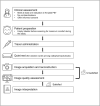International Nuclear Medicine Consensus on the Clinical Use of Amyloid Positron Emission Tomography in Alzheimer's Disease
- PMID: 37589025
- PMCID: PMC10425321
- DOI: 10.1007/s43657-022-00068-9
International Nuclear Medicine Consensus on the Clinical Use of Amyloid Positron Emission Tomography in Alzheimer's Disease
Abstract
Alzheimer's disease (AD) is the main cause of dementia, with its diagnosis and management remaining challenging. Amyloid positron emission tomography (PET) has become increasingly important in medical practice for patients with AD. To integrate and update previous guidelines in the field, a task group of experts of several disciplines from multiple countries was assembled, and they revised and approved the content related to the application of amyloid PET in the medical settings of cognitively impaired individuals, focusing on clinical scenarios, patient preparation, administered activities, as well as image acquisition, processing, interpretation and reporting. In addition, expert opinions, practices, and protocols of prominent research institutions performing research on amyloid PET of dementia are integrated. With the increasing availability of amyloid PET imaging, a complete and standard pipeline for the entire examination process is essential for clinical practice. This international consensus and practice guideline will help to promote proper clinical use of amyloid PET imaging in patients with AD.
Keywords: Alzheimer’s disease; Amyloid; Brain imaging; Expert consensus; Positron emission tomography (PET).
© The Author(s) 2022.
Conflict of interest statement
Conflicts of InterestThe authors declare that they have no conflict of interest.
Figures


References
-
- Akamatsu G, Ikari Y, Ohnishi A, Matsumoto K, Nishida H, Yamamoto Y, et al. Voxel-based statistical analysis and quantification of amyloid PET in the Japanese Alzheimer's disease neuroimaging initiative (J-ADNI) multi-center study. EJNMMI Res. 2019;9(1):91. doi: 10.1186/s13550-019-0561-2. - DOI - PMC - PubMed
LinkOut - more resources
Full Text Sources
